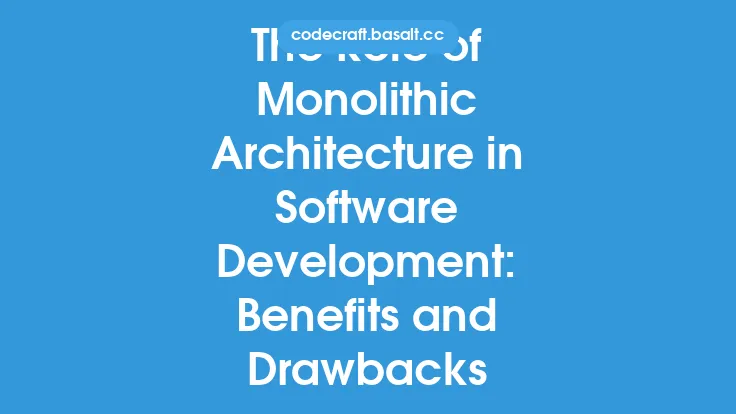When designing software systems, architects and developers often face a crucial decision: how to structure the application to ensure it is maintainable, scalable, and meets the required performance standards. One of the traditional approaches to software architecture is the monolithic architecture, where the entire application is built as a single, self-contained unit. In this article, we will delve into the implications of monolithic architecture on software maintenance and scalability, exploring the technical aspects and evergreen information that developers and architects need to consider.
Introduction to Monolithic Architecture
Monolithic architecture is characterized by a single, unified codebase that encompasses all the components and features of the application. This means that the user interface, business logic, database interactions, and other functionalities are all intertwined within the same codebase. While this approach can simplify the development process and reduce the complexity of the system, it also introduces several challenges when it comes to maintenance and scalability.
Impact on Software Maintenance
Maintaining a monolithic application can be a daunting task, especially as the codebase grows in size and complexity. Since all the components are tightly coupled, making changes to one part of the system can have unintended consequences on other parts, leading to a ripple effect of bugs and errors. This tight coupling also makes it difficult to isolate and debug issues, as the entire system needs to be considered when troubleshooting. Furthermore, the lack of clear boundaries between components means that developers need to have a deep understanding of the entire codebase, which can be a significant barrier to entry for new team members.
Technical Challenges in Monolithic Architecture
From a technical perspective, monolithic architectures often rely on a single technology stack, which can limit the flexibility and adaptability of the system. For example, if the application is built using a specific programming language or framework, it may be difficult to integrate new technologies or libraries that are not compatible with the existing stack. Additionally, the monolithic approach can lead to a phenomenon known as "technical debt," where the codebase becomes increasingly complex and difficult to maintain over time, requiring significant refactoring or rewriting to remain viable.
Scalability Concerns in Monolithic Architecture
Scalability is another significant concern in monolithic architectures. As the application grows in popularity or usage, the entire system needs to be scaled up to handle the increased load. This can be a challenging and expensive process, especially if the system is not designed with scalability in mind. Since all the components are tightly coupled, scaling one part of the system can have unintended consequences on other parts, leading to performance bottlenecks and decreased responsiveness. Moreover, the monolithic approach can make it difficult to take advantage of modern cloud computing and containerization technologies, which are designed to support scalable and distributed systems.
Comparison with Alternative Architectures
In contrast to monolithic architecture, alternative approaches such as microservices or modular architecture offer greater flexibility and scalability. These architectures break down the application into smaller, independent components that can be developed, deployed, and scaled separately. This allows for greater autonomy and flexibility, as each component can be built using the most suitable technology stack and scaled independently to meet changing demands. While these alternative architectures introduce their own set of challenges and complexities, they offer significant advantages when it comes to maintenance and scalability.
Best Practices for Mitigating the Risks of Monolithic Architecture
While monolithic architecture can present significant challenges, there are best practices that developers and architects can follow to mitigate these risks. One approach is to adopt a modular or component-based design, where the application is broken down into smaller, independent components that can be developed and maintained separately. This can help to reduce the complexity of the system and make it easier to isolate and debug issues. Another approach is to use design patterns and principles such as separation of concerns, dependency injection, and interface-based programming to reduce coupling and increase cohesion between components.
Conclusion
In conclusion, monolithic architecture can have significant implications for software maintenance and scalability. While it can simplify the development process and reduce complexity, it also introduces challenges such as tight coupling, technical debt, and scalability concerns. By understanding the technical aspects and evergreen information related to monolithic architecture, developers and architects can make informed decisions about when to use this approach and how to mitigate its risks. Ultimately, the choice of architecture depends on the specific needs and requirements of the application, and a deep understanding of the trade-offs and challenges involved is essential for building maintainable, scalable, and high-performance software systems.





